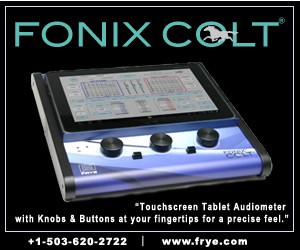ROCKVILLE, MARYLAND & RESTON, VIRGNIA — In response to published concerns by the Federal Communications Commission (FCC) that captioned telephone services (CTS) are being utilized by people who are not appropriate candidates—leading to potential funding deficits of this critical service—the American Academy of Audiology (AAA) and the American Speech-Language-Hearing Association (ASHA) have jointly developed proposed best practices for determining eligibility for the program.
CTS are designed to help people with hearing loss place and receive telephone calls by allowing them to speak directly to the called party and then listen and concurrently read captions of what the other party is saying.
These vital services are paid for by the Telecommunications Relay Service (TRS) Fund and administered by the FCC.
ADA, FCC and Captioned Telephone Services
Under the Americans with Disabilities Act (ADA), these services are offered free of charge to people who are deaf or hard of hearing. However, FCC regulations prohibit the use of CTS by people who do not have a hearing loss, including those with no hearing loss who reside in the same household as the person with hearing loss, as well as people with hearing loss whose hearing loss is adequately addressed by other amplification or services.
The use of CTS by individuals who have the capability of using conventional phone systems unnecessarily increases the cost of providing the TRS programs.
“The challenges associated with using the phone can contribute to isolating people with hearing loss, as well as negatively impacting educational opportunities, employment, and safety. This underscores the critical need to protect Captioned Telephone Services for those who truly need it. As such, ASHA is very pleased to collaborate with the American Academy of Audiology on these best practices, which will provide guidance to the members of our respective organizations as they care for their clients and patients.”
–ASHA President, Shari Robertson, PhD, CCC-SLP
“Audiologists play a vital role in evaluating and treating hearing loss to ensure that our patients can continue to work, go to school, or interact with family and friends at home,” said AAA President Lisa Christensen, AuD.
“As the expert on hearing loss and inner ear disorders, the audiologist is most qualified to evaluate whether a patient would be an ideal candidate for a captioned telephone. These best practices should serve as guidance to audiologists when determining the effectiveness of a captioned telephone for a certain patient. We thank ASHA for collaborating so effectively in developing these suggested best practices and look forward to continuing this work as the FCC continues to evaluate the CTS program.”
Best Practices for Determining Need for Captioned Phone Services
The suggested best practices are intended to cover both analog and Internet-provided phone captioning. Analog CTS is landline based, available over conventional phone lines. The Internet Protocol Captioned Telephone Service (IP CTS) is an Internet-based system that uses an existing voice telephone and a computer—or other Internet-connected device—rather than the conventional phone network to provide the link and captions between the individuals who are deaf or hard of hearing and another party. It can also be used as an app with a smartphone.
Nine suggested best practices are presented by the groups in this document. Among them are the following:
- Individuals seeking CTS should have communication impairment that significantly affects speech understanding, even when using amplification devices and a conventional phone.
- Individuals being considered for CTS should undergo an appropriate, comprehensive assessment to determine the need for assistive communication technologies, including CTS.
- The patient history should include questions designed to determine the disability associated with telephone use and the availability of existing telephone technologies (e.g., smartphone, visual communication options such as FaceTime, availability of amplified systems, etc.), and desired patient outcomes.
AAA and ASHA note that the organizations “support the availability of the CTS, including the IP CTS, to allow individuals who have the degree, type, or configuration that prevents traditional telephone use, to still be able to access telephone services. These same organizations also understand the necessity to restrict this service only to persons who are deaf or hard of hearing and support efforts to reduce the use of the service by those who do not have hearing loss in order to preserve the service.”
Interested readers can review the full document here: Suggested Best Practices for Audiologists’ Determination of Need for Captioned Phone Services.
Source: AAA, ASHA








Would love to see AAA and ASHA develop guidelines for owners, operators and managers of public spaces that would detail the needs of the hearing impaired while they navigate those spaces – with and without personal hearing aids or cochlear implants. Everything from the acoustical properties of a space to the installation of audio induction loop technology (for wireless and direct delivery of crystal clear sound to hearing devices) would be so helpful to so many people. A seamless and proactive approach is ideal, and would make every public space ADA-compliant.